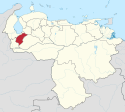Mérida (stan)
| stan | |||||
| |||||
| Państwo | |||||
|---|---|---|---|---|---|
| Siedziba | |||||
| Data powstania | |||||
| Gubernator | Florencio Porras | ||||
| Powierzchnia | 11 300 km² | ||||
| Populacja (2011) • liczba ludności |
| ||||
Położenie na mapie Wenezueli | |||||
| Strona internetowa | |||||
Mérida (hiszp.: Estado Mérida) – stan w Wenezueli ze stolicą w mieście Mérida.
Stan zajmuje powierzchnię 11 300 km²[1], a w roku 2011 zamieszkiwały go 828 592 osoby[2]. Dla porównania, w 1970 było ich 335,4 tys.[1]
Powierzchnia stanu jest górzysta, przebiega przez niego pasmo Cordillera de Mérida. Na terenie stanu wznosi się 76 szczytów o wysokości powyżej 4000 m[3]. W północno-zachodniej części małe niziny. Główną rzeką stanu jest Chama, nad którą leży stolica stanu. Stan jest miejscem uprawy kawy, hodowli bydła, trzody chlewnej oraz owiec. Rozwinięty przemysł włókienniczy i drzewny. Przez stan przebiega odgałęzienie Autostrady Panamerykańskiej[1].
Gminy i ich stolice
- Alberto Adriani (El Vigía)
- Andrés Bello (La Azulita)
- Antonio Pinto Salinas (Santa Cruz de Mora)
- Aricagua (Aricagua)
- Arzobispo Chacón (Canagua)
- Campo Elías (Ejido)
- Caracciolo Parra Olmedo (Tucaní)
- Cardenal Quintero (Santo Domingo)
- Guaraque (Guaraque)
- Julio César Salas (Arapuey)
- Justo Briceño (Torondoy)
- Libertador (Mérida)
- Miranda (Timotes)
- Obispo Ramos de Lora (Santa Elena de Arenales)
- Padre Noguera (Santa María de Caparo)
- Pueblo Llano (Pueblo Llano)
- Rangel (Mucuchíes)
- Rivas Dávila (Bailadores)
- Santos Marquina (Tabay)
- Sucre (Lagunillas)
- Tovar (Tovar)
- Tulio Febres Cordero (Nueva Bolivia)
- Zea (Zea)
Przypisy
Media użyte na tej stronie
Autor: Wilfredor, Licencja: CC BY-SA 4.0
„
- Attributes.—
The Meridenian Coat of Arms presents a compound shape tierced per fess. The Quarter of the Chief enameled in Or (yellow) shows three panoplies: two swords crossed in saltire at dexter; a cannon with a mast with open sails at center and on the sinister an arrow crossed with a rifle rebounded by a Phrygian Cap, all in its colors. The Central Quarter enameled in Azure (blue) presents a snow crested mountain with a lake where a boat is sailing at dexter and a prairie at sinister with a Silver (white) horse running from dexter to sinister but looking to the dexter. The Quarter of the Base enameled in Gules (red) charges two bundles: one of sugar cane at dexter and one of wheat at sinister with a book and a flaming votive lamp in the middle. As external ornaments the blazon shows a condor in attitude of begin the flight crowned by a five-pointed star in Argent (Silver) as crest and as supports a coffee branch at the dexter and a laurel branch at the sinister jointed by means of an Argent pennant charging as mottoes the following inscriptions: "ESTADO MERIDA" ("Merida State") at the center; "9 DE OCTUBRE DE 1558" ("October 9th, 1558") at the dexter and "16 DE SEPTIEMBRE DE 1810" ("September 16th, 1810") at the sinister.
- Semiology.—
On the First Quarter the crossed swords reminds the triumph of the Spaniard founders of the city of Mérida over the so called tyrant Lope de Aguirre; the cannon and the mast with open sails represent the continuous fights against the pirates on Gibraltar harbor whilst the arrow, the rifle and the Phrygian Cap alludes to Battle of Niquitao won by Rivas Dávila and his Meridenian army on 1813. The Second Quarter it's a general semblance of the Meridenian landscape: its snowed crests, its lacustrian depression and its mountain foot looking to the prairies. The horse maintains the characteristic posture of that appear on the Coat of Arms of Venezuela and remember too the Liberty. On the Third Quarter the bundles of sugar cane and wheat reminds the agricultural riches of the State whilst the book and flaming lamp symbolizes the Meridenian intellectual tradition and the creation of its University. The enamels Or, Azure and Gules constitutes a tribute to the Venezolanity. The condor remembers the Andean roots of the region. The star symbolizes the Province of Mérida at the moment of its join to the national emancipation. The coffee branch reaffirm the agricultural tradition of the State and the laurel one reminds the triumph of the efforts of its sons and daughters. The mottoes rebound the regional identity, the date of foundation of the capital of the State and the date of the begin of the Independency Movement of Venezuela.”
Autor: TUBS
Location of state of Mérida in Venezuela.






